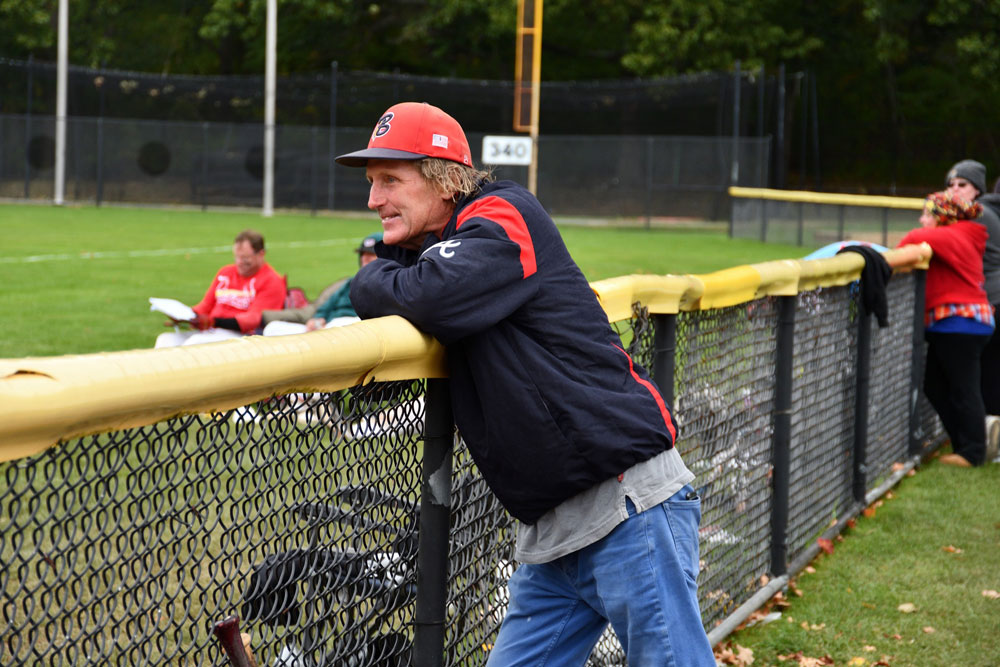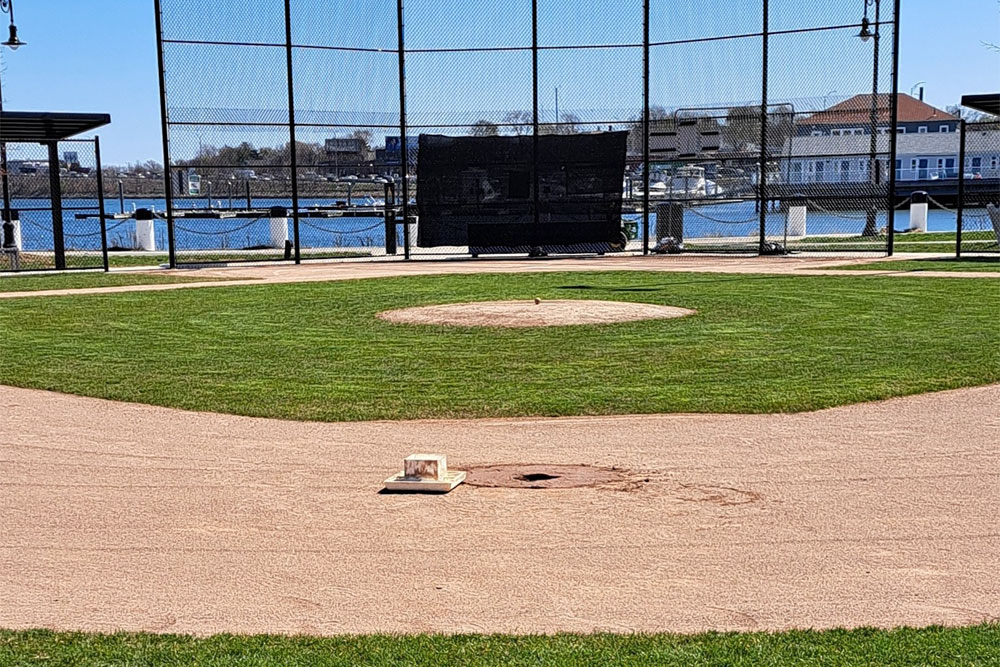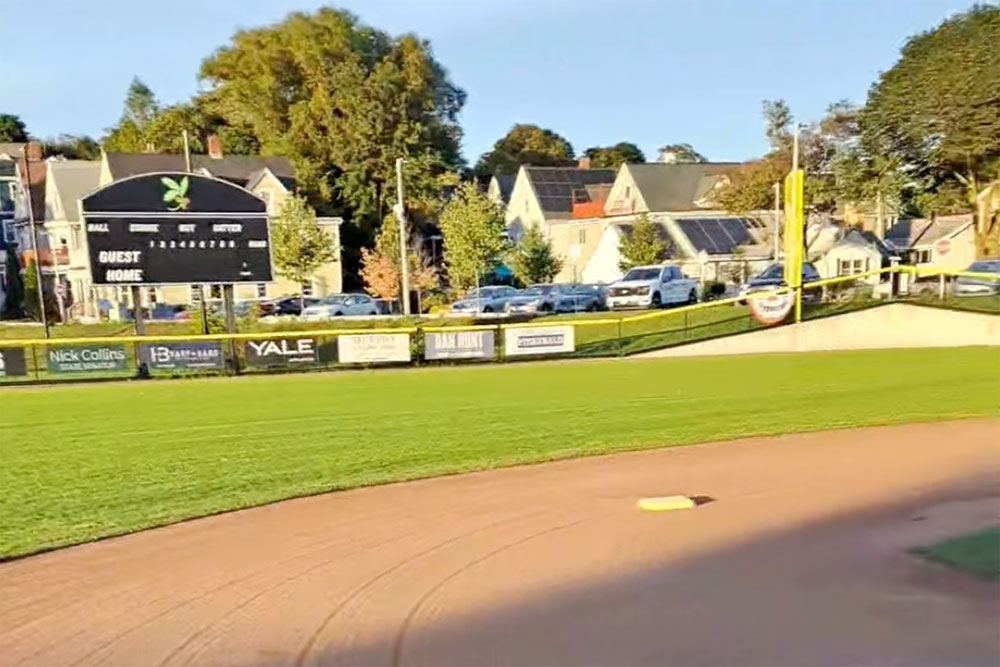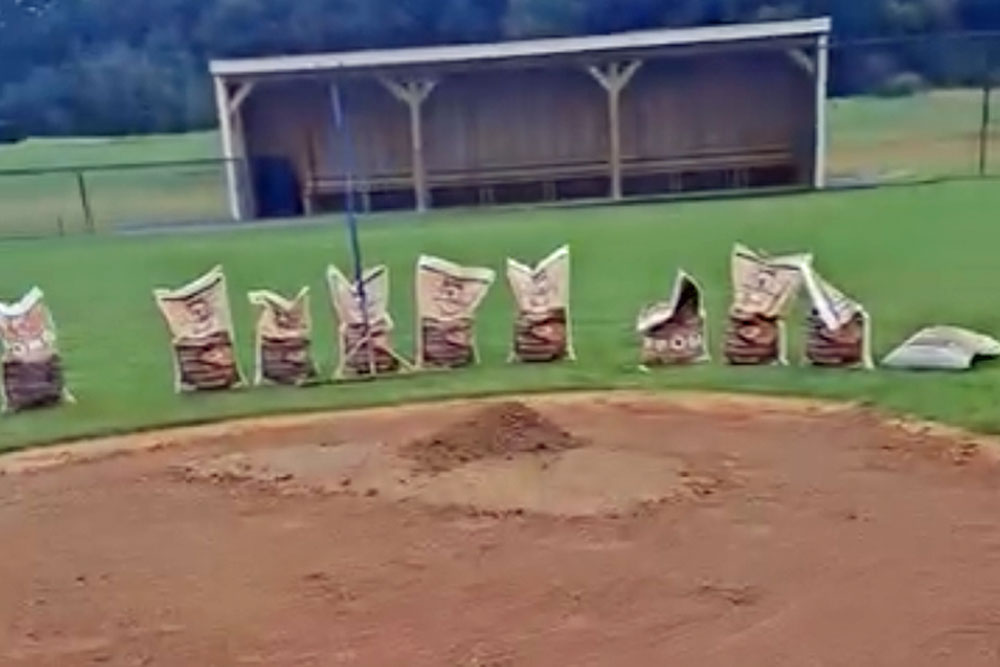Boston Park League Hall of Famer Charles “Curley” Peterson has turned his lifelong love of baseball into an art form — transforming Boston’s ballfields with unmatched precision, heart, and humor. His work proves that true craftsmanship doesn’t end when the game does.
From Fireballer to Keeper of the Game
Charles “Curley” Peterson has spent a lifetime around Boston baseball. A Boston Park League Hall of Famer and former pitcher at Northeastern University, Curley has gone from throwing strikes to shaping mounds. Today, he’s not known for his ERA or his fastball — he’s known for the perfect arc of his infields, the symmetry of his warning tracks, and the precision with which he can tell whether a field needs love just by looking at it.
He’s the rare kind of craftsman who views a baseball diamond as something sacred. He’ll volunteer for hours, load 8,000 pounds of infield mix by hand, or edge every inch of grass until it’s picture-perfect — all because, as he puts it, “When you’ve got a special gift, one should always use it.”
Boston’s baseball community knows Curley not just for his fields, but for his philosophy. He works with the patience of a sculptor, the humility of a volunteer, and the conviction of someone who truly believes the game deserves more than the bare minimum.

How a Northeastern Pitcher Found His True Calling
“Interesting,” Curley begins, when asked how it all started. “It was my first co-op job at Northeastern University when I pitched there 50 years ago and kind of liked it. I said, you know, this is pretty cool. I didn’t realize that this was going to become my profession — in my late 50s and 60s, though.”
That’s how Curley tells it — straightforward, meandering, but full of warmth. He speaks as though each word is raked into place, like the lines of a freshly dragged infield. Back then, as a college pitcher, he was learning the basics of both baseball and life: timing, patience, precision. The idea that he would one day return to fields not as a player but as their caretaker was unthinkable. But somewhere along the way, baseball called him back — not to throw, but to restore.
“You can just walk onto a field and look at it,” he explains. “You can see what needs to be worked. That being said, getting their permission to do a field is another thing, and it’s not always that easy.”
That line sums up Curley perfectly — a mix of quiet confidence and practicality. He sees every mound as a living thing, every lip of grass as a reflection of how much the game is respected in that neighborhood. He’s not a hired contractor; he’s a field whisperer, someone who understands that good dirt, like good pitching, is built one layer at a time.
The Gospel According to Dirt at Cunningham Park
Curley’s most recent project might be his proudest. “I went to Cunningham Park just two days ago,” he recalls, his voice rising like he’s back on the mound again. “I introduced myself to Gary Kelley, the proprietor there. Once I started talking to him and he realized that I knew what I was talking about, he says, ‘You want to play with the mound?’ I says, ‘Oh, certainly.’ So I edged it, pounded down the edges, and added 7,000 pounds of dirt. And lo and behold, right now, today, it’s probably the best mound in eastern Mass.”
He laughs as he says it, but he means it. He’s proud because he knows what it takes — and he’s seen what happens when it’s not done right. “Most people don’t realize that an average mound contains about 25,000 pounds of infield mix and packing clay combination,” he says. “Depending upon how much money you have and how you want to have it done.”
From there, Curley launches into an impromptu master class on field engineering. He talks about wedge layering, the importance of clay content, and how Fenway Park’s infield mix sets the gold standard. “If you got resources, we put conditioner on top,” he explains. “Fenway’s infield looks beautiful because they have that red calcine clay on top. God, they have the best infield mix you can imagine — like 30% clay content — very stable but porous. That’s a good infield.”
His voice takes on the cadence of a preacher. It’s not just dirt to him — it’s devotion. To Curley, a perfectly built mound is a form of worship. It’s where a pitcher can trust his footing, where a game can stay true, and where a community can take pride in its home field.
Below is a field Curley brought back to life at Savin Hill.

Hand Tools, Heart, and the McConnell Way
When Curley talks about McConnell Park in Dorchester, there’s a clear sense of ownership — not possession, but stewardship. “My main field is McConnell Park in Dorchester,” he says. “It’s a Little League field — decomposed granite, DG for short. You stake out the back of the plate, run a string line 190 feet, paint the arc, and half-moon edge it. I find that if you use hand tools, it’s actually better than a grooming machine.”
To most people, that sounds like tedious work. To Curley, it’s meditation. “One man,” he posted after another long day, “after 50 hours of edging, tamping, and raking — McConnell Park by the sea is as good as any multi-manned company could do. Actually, I’m lying. This is better.”
That blend of self-deprecation and swagger is pure Curley. He’ll say it with a grin, but he knows exactly what he’s capable of. Across Boston, his fingerprints are on fields that most players never realize he’s touched — Parkway Little League, Roger’s Park in Brighton, the Rice Complex in Wrentham. At Roger’s, he logged six hours one day and used “8,000 pounds of infield mix and 50 gallons of water,” done “in layers, four wheelbarrows full each layer.” He laughs as he recalls it: “Now Roger’s Park has the best mound in the city.”
Even the Cape Cod League has felt his impact. “I happened to be going down to Bourne,” he says, “to visit my mother and father. My mother had just passed away a week earlier. It was pouring rain. I stopped by, saw a guy mowing the grass, and started talking to him. Then the president of the club comes running down the field and asks if I work there. I said, ‘No, but I did sleep at a Holiday Inn last night.’”
He pauses for effect, chuckling. “Then I said, ‘By the way, I’m a professional groundskeeper.’ By the time I’d finished that mound, Scott Landers — the great Cape Cod League coach — says, ‘You don’t happen to do mounds, do you?’ I look up and said, ‘Well, that just happens to be my specialty.’ And the rest is history.”
It’s vintage Curley — a mixture of happenstance, hustle, and humor. One minute he’s there to pay respects to his family; the next, he’s shaping the perfect landing zone for a future major leaguer.

Faith, Sweat, and Treasures in Heaven
Curley doesn’t bill by the hour. He bills by the heart.
“Generally, I do,” he says when asked who pays for supplies. “I volunteer. My saying is, you got to give a little to get a lot.”
Then his tone softens. “This may sound a little corny to most people, but I realized very early in life that I need to lay up treasures in heaven where neither moth nor rust can destroy. Getting paid is important, but I know I’ll get paid handsomely in the Kingdom.”
It’s not just talk — it’s how he lives. His Facebook posts often read like parables, merging scripture with sweat equity. In one, he quotes the Gospel of Matthew: “The story of the talents… When you’ve got a special gift, one should always use it. It’s not always about being paid monetarily. It’s more important to store up treasures in heaven where neither moth nor rust can destroy.”
That’s not just his faith talking — it’s his field philosophy. Every rake, every tamp, every bag of clay he hauls by hand is an act of gratitude. “What is there not to like,” he once wrote, “about working for Dorchester Baseball at McConnell by the Sea… another first-class organization that TRULY appreciates my value.”
He doesn’t just fix dirt — he restores dignity to community fields. In Wrentham, he spent days rebuilding the Chuck Horn baseball field with nothing but hand tools. “The best job I ever had,” he wrote. “No machines — just hand tools. It was sad in a way, tarping the mound and plate knowing I was done for this chapter. But hopeful come next spring after the winter’s bitter snow, that the Chuck Horn field will emerge again as the rose that blooms brightest in the town of Wrentham.”
That’s the poetry of Charles Peterson — heartfelt, unedited, and entirely his own.

The Engineer of Boston Baseball’s Soul
Ask Curley where he ranks among field specialists, and he won’t hesitate. “In my opinion,” he says with a grin, “I may be the best field engineer in the state. They’re all good… and it’s a pleasure to be recognized and wanted to maintain our area’s best ball fields.”
But what separates him isn’t bravado — it’s devotion. He does it for the love of the game, the pride of the players, and the belief that a perfect infield honors baseball itself. For him, a clean edge or a stable mound isn’t cosmetic — it’s spiritual. It’s what baseball should look like.
And for those who cross paths with him — whether it’s at McConnell Park, the Rice Complex, or a hidden gem like Cunningham — they’re left with the unmistakable imprint of a man who treats every field like Fenway.
When the work is done and the tools are put away, Curley smiles with quiet pride, knowing he’s left the field better than he found it.
Charles “Curley” Peterson doesn’t just maintain fields — he tends to the very soul of the game.
Brett Rudy is a trailblazer in the world of baseball. As the founder of Baseball Is My Life and co-founder of Charity Hop Sports Marketing, he’s dedicated to elevating the sport and supporting the athletes who play it. With a passion for making a difference, Brett has created successful philanthropic initiatives like Charity Wines and 100 Innings of Baseball for ALS. He’s also the mastermind behind the Corked Bat Collection, Cooperstown Classic at the Baseball Hall of Fame, and Winterball for Toys for Tots. When he’s not working to improve the game, Brett can be found playing outfield in the Boston Metro Baseball League, living and breathing the sport he loves.